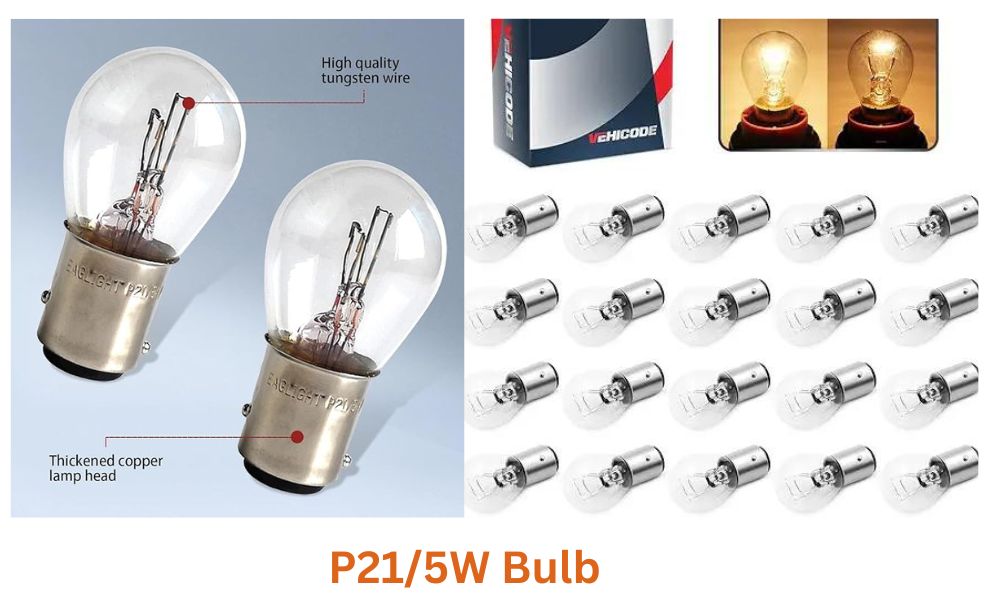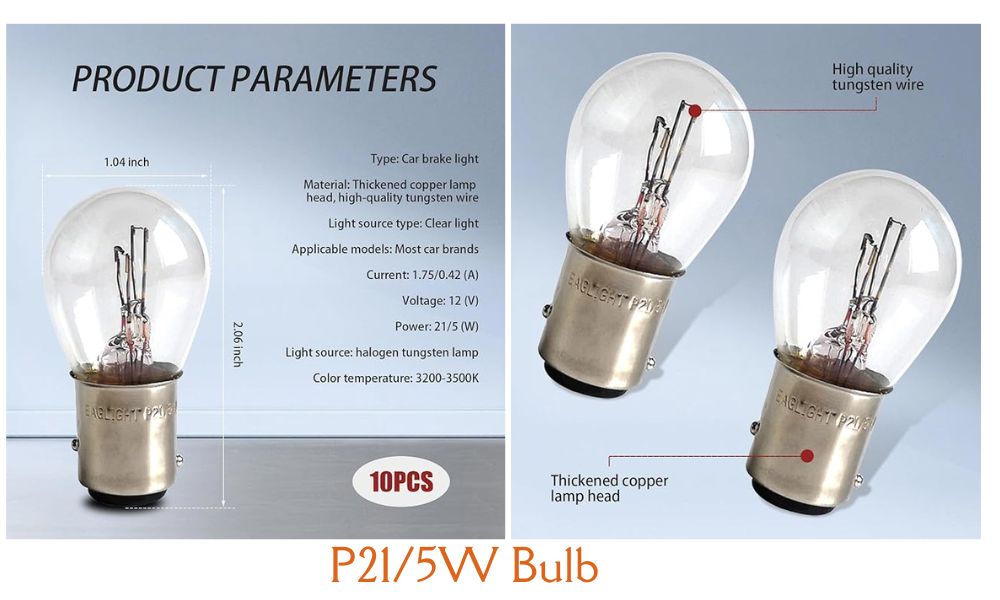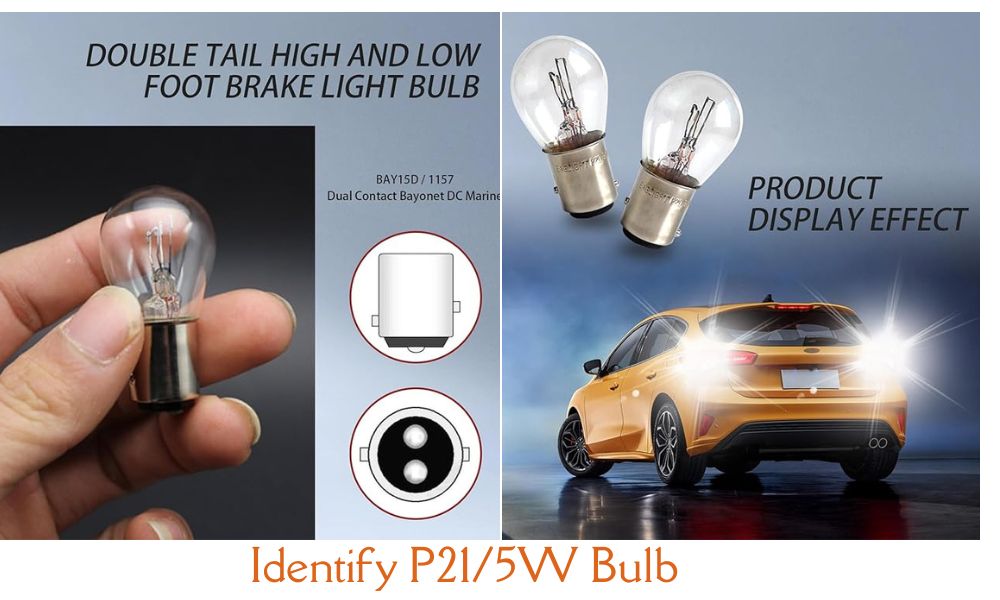If you’ve ever looked closely at your car’s lights, you might have noticed different types of bulbs used for various functions. One such bulb is the P21/5W bulb. It’s a common type of light bulb used in many vehicles, but what exactly is it, and why is it so important? Let’s dive deep into the details to understand this small yet vital component of your vehicle.

What is a P21/5W Bulb?
A P21/5W bulb is a type of dual-filament bulb often used in car lighting systems. The “P21/5W” stands for the specific characteristics of the bulb:
- P: Refers to the base type of the bulb.
- 21/5W: Indicates the wattage of the bulb. This means the bulb has two filaments, one that uses 21 watts and another that uses 5 watts.
The dual-filament feature allows the bulb to perform two different functions, often in the same housing. For example, it can be used for both the tail light and brake light, with the lower wattage filament (5W) for the tail light and the higher wattage filament (21W) for the brake light.
Where is the P21/5W Bulb Used?
The P21/5W bulb is most commonly found in the rear lights of vehicles. It serves two main purposes:
1. Tail Lights: The 5W filament is typically used for the tail lights. This is the light that stays on when your vehicle’s headlights are on, helping other drivers see your car in low-light conditions.
2. Brake Lights: The 21W filament is used for the brake lights. These lights turn on when you press the brake pedal, signaling to drivers behind you that you are slowing down or stopping.
This dual-functionality makes the P21/5W bulb essential for both safety and visibility on the road.
The Importance of the P21/5W Bulb in Road Safety
Imagine driving at night without proper tail lights or brake lights. It would be challenging for other drivers to see you, increasing the risk of accidents. The P21/5W bulb plays a crucial role in preventing such situations by ensuring that your vehicle is visible and that your intentions (like braking) are clear to others on the road.
This is why it’s so important to ensure that your P21/5W bulbs are functioning correctly. A burned-out bulb can compromise your safety and that of others. Regular checks and timely replacements can make a significant difference.

How to Identify a P21/5W Bulb?
When it comes to replacing your vehicle’s bulbs, it’s essential to know how to identify the correct one. The P21/5W bulb can usually be recognized by its base type and wattage marking. Here’s what to look for:
- Base Type: The P21/5W bulb has a BA15d base, which is a bayonet-type base with two pins on the sides. The “d” in BA15d stands for “double contact,” which refers to the dual-filament design.
- Wattage Marking: The bulb will have “21/5W” marked on it, indicating the two different wattages for the dual filaments.
If you’re unsure about identifying the bulb, you can always refer to your vehicle’s manual or consult with a professional mechanic.
Why Choose a P21/5W Bulb?
There are several reasons why you choose the P21/5W bulb for vehicle lighting:
1. Dual Functionality: The ability to use the same bulb for both tail lights and brake lights simplifies the design of the vehicle’s lighting system.
2. Energy Efficiency: The low wattage of the 5W filament means that it uses minimal energy when the tail lights are on, contributing to overall fuel efficiency.
3. Visibility: The higher wattage of the 21W filament ensures that the brake lights are bright enough to catch the attention of drivers behind you, enhancing road safety.
These advantages make the P21/5W bulb a reliable and practical choice for vehicle lighting.
Common Issues with P21/5W Bulbs
Like any other component, the P21/5W bulb is not immune to wear and tear. The following are some common problems you may encounter:
- Burned-Out Filament: Over time, one or both filaments in the bulb may burn out, leading to reduced visibility. If the 21W filament burns out, your brake lights won’t function, which can be dangerous.
- Corrosion: The bulb’s base can sometimes corrode, especially in regions with high humidity or road salt. Corrosion can lead to poor electrical contact, causing the bulb to flicker or fail.
- Loose Fit: If the bulb is not securely fitted in its socket, it may move around, leading to inconsistent lighting. This is often due to a worn-out socket or improper installation.
Regular maintenance and timely replacement of faulty bulbs can help avoid these issues.

How to Replace a P21/5W Bulb?
Replacing a P21/5W bulb is a relatively simple task that you can do yourself. Here’s a step-by-step guide:
1. Locate the Bulb: Identify the tail light housing on your vehicle. This is usually accessible from the trunk or rear hatch.
2. Remove the Housing: Depending on your vehicle, you may need to remove screws or clips to access the bulb housing.
3. Remove the Old Bulb: To separate the bulb socket from the housing, gently twist it. Then, pull the old bulb out of the socket.
4. Install the New Bulb: After that, reposition the socket within the housing, ensuring that it fits securely.
5. Test the Bulb: Before reassembling the housing, test the bulb to make sure both filaments (tail light and brake light) are working correctly.
If you’re unsure about the process, it’s always a good idea to consult your vehicle’s manual or seek professional help.
Alternatives to the P21/5W Bulb
While the P21/5W bulb is widely used, there are alternatives available depending on your needs:
- LED Bulbs: LED versions of the P21/5W bulb are available and offer several benefits, including longer life, brighter light, and lower energy consumption. However, they may require a compatible socket or adapter.
- Halogen Bulbs: Some vehicles use halogen bulbs as an alternative to the traditional P21/5W bulb. These bulbs offer brighter light but may consume more energy and generate more heat.
When considering alternatives, it’s essential to ensure that they are compatible with your vehicle’s lighting system.
Conclusion: Why the P21/5W Bulb Matters
The P21/5W bulb may seem like a small and insignificant part of your vehicle, but it plays a crucial role in ensuring your safety on the road. By providing both tail light and brake light functions, it helps other drivers see you and understand your intentions, reducing the risk of accidents.
Regularly checking and maintaining your P21/5W bulbs is a simple yet effective way to ensure your vehicle remains safe and visible. Whether you choose the traditional bulb or opt for an LED or halogen alternative, make sure that your lights are always in top condition.
Remember, in the world of driving, visibility is everything, and the P21/5W bulb is your reliable partner in staying safe on the road.
By understanding the importance, functionality, and maintenance of the P21/5W bulb, you’re not only ensuring your vehicle’s safety but also enhancing your knowledge as a responsible driver. So, the next time you think about your car’s lights, give a nod to the humble P21/5W bulb, your vehicle’s unsung hero.
Related articles:


